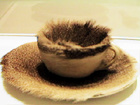 Wallace Berman took this photograph of his son Tosh in 1960. Silver gelatin print; taken in 1960, printed in 2006. h: 20 x w: 16 in. In an interview with Tosh:
Wallace Berman took this photograph of his son Tosh in 1960. Silver gelatin print; taken in 1960, printed in 2006. h: 20 x w: 16 in. In an interview with Tosh:3:AM: It would be remiss of me not to mention your father, Wallace Berman. He’s being undergoing a bit of a revival in recent years - there have been some retrospectives of his work, but also Stewart Home has cribbed the ethos of Semina for his imprint. How much of an influence is Semina on your work, if at all?[LINK to the above.]
TB: My Dad is a major influence on me. He taught me to go against the grain and listen to that inner voice. I am surrounded by two geniuses in my life: my dad and my wife. Both are creatures of the creative, and I feel like I am in their shadow – but what a great place to be in. They both taught me to go by instinct. And instinct is the core of the creative act.
Semina is sort of the self-made ‘zine of its time. He just did it without thinking out the commercial aspect. So in one sense it was a pure piece of work. Very personal and therefore beautiful. I think of TamTam in that manner. I just want to show the public what turns me on. So in a sense, it’s a sharing feeling. I don’t care about the masses, I just want people who are interested in what I am doing. Ten people into Boris Vian is good enough for me.
See an earlier entry titled "Trippy sardonic West Coast surrealism."

 Is '60 the moment when the end of the end of the Old Left had been reached and the New Left began to emerge? Is it the final ascendancy, in certain scenes at least, of poetic postmodernity? Surely the publication of Donald Allen's The New American Poetry that year suggests this, but then again--once again--we look back on "New" here and see continuity. The rhetoric of the Kennedy-Nixon contest made much less of a dent than everyone (at the time as well as since) claimed, so one wonders why were such great claims made?
Is '60 the moment when the end of the end of the Old Left had been reached and the New Left began to emerge? Is it the final ascendancy, in certain scenes at least, of poetic postmodernity? Surely the publication of Donald Allen's The New American Poetry that year suggests this, but then again--once again--we look back on "New" here and see continuity. The rhetoric of the Kennedy-Nixon contest made much less of a dent than everyone (at the time as well as since) claimed, so one wonders why were such great claims made?  Had we come to expect "1960" to be truly ubiquitously modern in a way that the 1950s really were not--not quite? And what specifically does "modern" mean in the Kennedyesque talk then and now about the torch being passed to a new generation, etc.? The First Lady really meant "modernist" when Camelotians said "modern." What about the others across the new young cultural leadership? I've been surprised by how frequently the
Had we come to expect "1960" to be truly ubiquitously modern in a way that the 1950s really were not--not quite? And what specifically does "modern" mean in the Kennedyesque talk then and now about the torch being passed to a new generation, etc.? The First Lady really meant "modernist" when Camelotians said "modern." What about the others across the new young cultural leadership? I've been surprised by how frequently the  "Beat movement" was covered in 1960 in the mainstream press. I was expecting a fair measure but I've found tonnage. 1960 was the year when the figure of the beat was beginning to find acceptance, although still 80% of these stories are mocking, rebels-without-cause condescension. For anyone whose analysis made an impact nationally, do these antipolitical adolescents count as part of the "new young cultural leadership"? No, but rather than the two being opposites, they fall along a Continuum of the New American. Now that's a change for '60.
"Beat movement" was covered in 1960 in the mainstream press. I was expecting a fair measure but I've found tonnage. 1960 was the year when the figure of the beat was beginning to find acceptance, although still 80% of these stories are mocking, rebels-without-cause condescension. For anyone whose analysis made an impact nationally, do these antipolitical adolescents count as part of the "new young cultural leadership"? No, but rather than the two being opposites, they fall along a Continuum of the New American. Now that's a change for '60.







